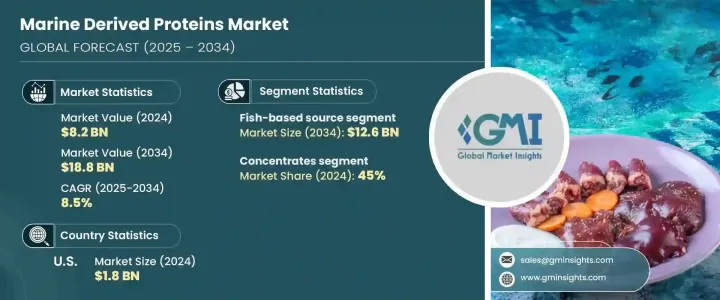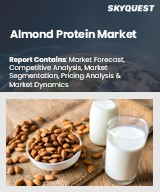
|
시장보고서
상품코드
1685118
해양 유래 단백질 시장 기회, 성장 촉진요인, 산업 동향 분석, 예측(2025-2034년)Marine Derived Proteins Market Opportunity, Growth Drivers, Industry Trend Analysis, and Forecast 2025 - 2034 |
||||||
세계의 해양 유래 단백질 시장은 2024년 82억 달러로 평가되었고 고품질의 지속가능한 단백질원에 대한 소비자 수요 증가에 견인되어 2025년부터 2034년까지 연평균 복합 성장률(CAGR) 8.5%를 나타낼 것으로 예측되고 있습니다.
이 상승 동향은 필수 아미노산, 오메가 3 지방산, 생물활성 화합물을 풍부하게 포함하는 해양 단백질의 인기 상승에 추진되고 있습니다. 건강 지향 소비자가 영양 밀도가 높은 식품을 요구하는 가운데, 해양 단백질은 다양한 식사와 기능성 분야에서 선호되는 옵션으로 부상하고 있습니다.

환경의 지속가능성과 윤리적인 식품조달에 대한 우려 증가도 소비자의 취향을 변화시키고 있으며, 해양 유래 단백질의 채용률의 상승으로 이어지고 있습니다. 이러한 단백질은 기존의 동물성 단백질, 특히 해조류 단백질에 대한 지속 가능한 대안을 제공하며, 식물성 및 친환경 식단 운동에 부합합니다. 또한 식품가공기술의 진보로 해양단백질의 생물학적 이용능력과 기능적 특전이 강화되어 영양보조식품, 스포츠영양, 의약품 용도로의 이용이 더욱 매력적이 되고 있습니다.
| 시장 범위 | |
|---|---|
| 시작 연도 | 2024년 |
| 예측 연도 | 2025-2034년 |
| 시작 금액 | 82억 달러 |
| 예측 금액 | 188억 달러 |
| CAGR | 8.5% |
해양 유래 단백질 시장은 원료별로 조개류, 어류, 해조류 등으로 분류됩니다. 어류 단백질이 시장을 독점해 2024년에는 55억 달러를 생산했고, 2034년에는 126억 달러에 이를 것으로 예측됩니다. 뛰어난 영양 프로파일과 식품, 의약품, 화장품에 걸친 다목적 용도가 시장 성장의 주요 촉진요인이 되고 있습니다. 조개류 단백질은 높은 생체 이용률과 영양 보충제, 반려동물 영양, 기능성 식품에 대한 광범위한 응용으로 빠르게 지지를 받고 있습니다. 해조류 단백질은 지속 가능하고 식물 친화적인 대안으로 수요가 가속적으로 증가하고 있으며 환경 친화적인 단백질 공급원을 찾는 소비자에게 호소하고 있습니다. 환경에 미치는 영향을 최소화하면서 고단백질을 공급할 수 있기 때문에 이 시장에서는 강력한 경쟁 상대가 되고 있습니다.
형태별로 시장은 농축액, 가수분해물, 분리물로 나뉩니다. 농축액 부문은 합리적인 가격, 제조 용이성, 균형 잡힌 영양 특성으로 인해 2024년에는 45%의 압도적 점유율을 차지했습니다. 농축액은 단리물이나 가수분해물에 비해 단백질의 대부분을 유지한 채 최소한의 처리로 끝나기 때문에 기능성 식품, 식음료, 사료에 최적입니다. 다양한 산업에서 널리 채택되는 것은 비용 효율성과 진화하는 소비자 요구를 충족시키는 능력을 뒷받침합니다.
2024년 미국의 해양 유래 단백질 시장 규모는 18억 달러에 달했습니다. 건강·웰니스 제품에 대한 관심이 높아짐에 따라 강력한 성장이 전망되고 있습니다. 소비자는 오메가 3 지방산과 필수 영양소가 풍부한 고품질의 단백질 공급원을 선호합니다.
선수와 피트니스 애호가가 깨끗하고 생물학적 이용능력이 높은 단백질원을 요구하는 가운데, 스포츠 영양분야의 확대가 이 상승 기조를 더욱 뒷받침하고 있습니다. 게다가 지속가능성에 대한 우려가 구매결정에 영향을 미치고 있으며, 각 제조업체는 환경 의식이 높은 소비자의 선호도에 따라 환경 친화적인 해양 단백질 솔루션의 개발을 촉구하고 있습니다.
시장이 진화를 계속하고 있는 가운데, 해양 단백질의 추출, 가공, 응용에 있어서의 기술 혁신이 성장을 가속시킬 것으로 예상됩니다. 소비자가 영양가가 높고 지속 가능한 식품을 선택하게 됨에 따라 해양 유래 단백질은 세계의 단백질 업계에서 중요한 위치를 차지하게 되어 영양보조식품 및 기능성 영양 식품 업계의 미래를 형성할 것으로 보입니다.
목차
제1장 조사 방법과 조사 범위
- 시장 범위와 정의
- 기본 추정과 계산
- 예측 계산
- 데이터 소스
제2장 주요 요약
제3장 업계 인사이트
- 생태계 분석
- 밸류체인에 영향을 주는 요인
- 이익률 분석
- 파괴적 혁신
- 향후 전망
- 제조업체
- 유통업체
- 공급업체 상황
- 이익률 분석
- 주요 뉴스
- 규제 상황
- 영향요인
- 성장 촉진요인
- 필수 영양소가 풍부
- 운동 능력 향상
- 인지 기능 향상
- 업계의 잠재적 위험 및 과제
- 오염 및 오염물질
- 성장 촉진요인
- 성장 가능성 분석
- Porter's Five Forces 분석
- PESTEL 분석
제4장 경쟁 구도
- 서론
- 기업 점유율 분석
- 경쟁 포지셔닝 매트릭스
- 전략 전망 매트릭스
제5장 시장 규모와 예측 : 원료별(2021-2034년)
- 주요 동향
- 어류
- 조개류
- 해조류
- 기타
제6장 시장 규모와 예측 : 형태별(2021-2034년)
- 주요 동향
- 농축액
- 가수분해물
- 분리물
제7장 시장 규모와 예측 : 유통 채널별(2021-2034년)
- 주요 동향
- 직접 판매
- 유통업체
- 소매
제8장 시장 규모와 예측 : 지역별(2021-2034년)
- 주요 동향
- 북미
- 미국
- 캐나다
- 유럽
- 영국
- 독일
- 프랑스
- 이탈리아
- 스페인
- 러시아
- 아시아태평양
- 중국
- 인도
- 일본
- 한국
- 호주
- 라틴아메리카
- 브라질
- 멕시코
- 중동 및 아프리카
- 남아프리카
- 사우디아라비아
- 아랍에미리트(UAE)
제9장 기업 프로파일
- Aker BioMarine
- Aquaculture Protein
- Biomega Group
- Cargill
- Cellulac
- Corbion
- DSM
- Epax
- FMC Corporation
- Kerry Group
- Lonza
- Neptune Wellness Solutions
- Nippon Suisan Kaisha
- Royal Greenland
- SkyBiometry
The Global Marine Derived Proteins Market, valued at USD 8.2 billion in 2024, is projected to expand at a CAGR of 8.5% between 2025 and 2034, driven by increasing consumer demand for high-quality, sustainable protein sources. This upward trend is fueled by the rising popularity of marine proteins, which are rich in essential amino acids, omega-3 fatty acids, and bioactive compounds. As health-conscious consumers seek nutrient-dense food options, marine proteins are emerging as a preferred choice across various dietary and functional applications.

Growing concerns over environmental sustainability and ethical food sourcing are also reshaping consumer preferences, leading to higher adoption of marine-derived proteins. These proteins provide a sustainable alternative to traditional animal-based proteins, particularly algae-based options, which align with plant-based and eco-conscious dietary movements. Additionally, advancements in food processing technologies are enhancing the bioavailability and functional benefits of marine proteins, making them more appealing for use in nutraceuticals, sports nutrition, and pharmaceutical applications.
| Market Scope | |
|---|---|
| Start Year | 2024 |
| Forecast Year | 2025-2034 |
| Start Value | $8.2 Billion |
| Forecast Value | $18.8 Billion |
| CAGR | 8.5% |
By source, the marine-derived proteins market is categorized into shellfish-based, fish-based, algae-based, and others. Fish-based proteins dominated the market, generating USD 5.5 billion in 2024 and projected to reach USD 12.6 billion by 2034. Their exceptional nutritional profile and versatile applications across food, pharmaceuticals, and cosmetics make them a key driver of market growth. Shellfish-based proteins are rapidly gaining traction due to their high bioavailability and widespread application in dietary supplements, pet nutrition, and functional foods. Algae-based proteins are witnessing an accelerated rise in demand as sustainable, plant-friendly alternatives, appealing to consumers looking for environmentally responsible protein sources. Their ability to deliver high protein content with minimal ecological impact makes them a strong competitor in the market.
In terms of form, the market is divided into concentrates, hydrolysates, and isolates. The concentrates segment held a dominant 45% share in 2024, driven by its affordability, ease of production, and balanced nutritional properties. Compared to isolates and hydrolysates, concentrates undergo minimal processing while retaining a significant portion of protein, making them an ideal choice for functional foods, beverages, and animal feed. Their widespread adoption across various industries underscores their cost-effectiveness and ability to meet evolving consumer needs.
The U.S. marine-derived proteins market was valued at USD 1.8 billion in 2024, with strong growth prospects driven by increasing interest in health and wellness products. Consumers are prioritizing high-quality protein sources rich in omega-3 fatty acids
and essential nutrients, contributing to surging demand for marine-based dietary supplements and functional foods. The expanding sports nutrition sector further supports this upward trajectory, as athletes and fitness enthusiasts seek clean, bioavailable protein sources. Additionally, sustainability concerns are influencing purchasing decisions, prompting manufacturers to develop eco-friendly marine protein solutions that align with environmentally conscious consumer preferences.
As the market continues to evolve, innovation in marine protein extraction, processing, and application is expected to accelerate growth. With consumers shifting toward nutritional and sustainable food choices, marine-derived proteins are set to become a crucial part of the global protein landscape, shaping the future of dietary and functional nutrition industries.
Table of Contents
Chapter 1 Methodology & Scope
- 1.1 Market scope & definition
- 1.2 Base estimates & calculations
- 1.3 Forecast calculation
- 1.4 Data sources
- 1.4.1 Primary
- 1.4.2 Secondary
- 1.4.2.1 Paid sources
- 1.4.2.2 Public sources
Chapter 2 Executive Summary
- 2.1 Industry synopsis, 2021-2034
Chapter 3 Industry Insights
- 3.1 Industry ecosystem analysis
- 3.1.1 Factor affecting the value chain
- 3.1.2 Profit margin analysis
- 3.1.3 Disruptions
- 3.1.4 Future outlook
- 3.1.5 Manufacturers
- 3.1.6 Distributors
- 3.2 Supplier landscape
- 3.3 Profit margin analysis
- 3.4 Key news & initiatives
- 3.5 Regulatory landscape
- 3.6 Impact forces
- 3.6.1 Growth drivers
- 3.6.1.1 Rich in essential nutrients
- 3.6.1.2 Improved athletic performance
- 3.6.1.3 Enhanced cognitive function
- 3.6.2 Industry pitfalls & challenges
- 3.6.2.1 Pollution and contaminants
- 3.6.1 Growth drivers
- 3.7 Growth potential analysis
- 3.8 Porter’s analysis
- 3.9 PESTEL analysis
Chapter 4 Competitive Landscape, 2024
- 4.1 Introduction
- 4.2 Company market share analysis
- 4.3 Competitive positioning matrix
- 4.4 Strategic outlook matrix
Chapter 5 Market Size and Forecast, By Source, 2021-2034 (USD Billion) (Kilo Tons)
- 5.1 Key trends
- 5.2 Fish-based
- 5.3 Shellfish-based
- 5.4 Algae-based
- 5.5 Other
Chapter 6 Market Size and Forecast, By Form, 2021-2034 (USD Billion) (Kilo Tons)
- 6.1 Key trends
- 6.2 Concentrates
- 6.3 Hydrolysates
- 6.4 Isolates
Chapter 7 Market Size and Forecast, By Distribution Channel, 2021-2034 (USD Billion) (Kilo Tons)
- 7.1 Key trends
- 7.2 Direct sales
- 7.3 Distributors
- 7.4 Retail
Chapter 8 Market Size and Forecast, By Region, 2021-2034 (USD Billion) (Kilo Tons)
- 8.1 Key trends
- 8.2 North America
- 8.2.1 U.S.
- 8.2.2 Canada
- 8.3 Europe
- 8.3.1 UK
- 8.3.2 Germany
- 8.3.3 France
- 8.3.4 Italy
- 8.3.5 Spain
- 8.3.6 Russia
- 8.4 Asia Pacific
- 8.4.1 China
- 8.4.2 India
- 8.4.3 Japan
- 8.4.4 South Korea
- 8.4.5 Australia
- 8.5 Latin America
- 8.5.1 Brazil
- 8.5.2 Mexico
- 8.6 MEA
- 8.6.1 South Africa
- 8.6.2 Saudi Arabia
- 8.6.3 UAE
Chapter 9 Company Profiles
- 9.1 Aker BioMarine
- 9.2 Aquaculture Protein
- 9.3 Biomega Group
- 9.4 Cargill
- 9.5 Cellulac
- 9.6 Corbion
- 9.7 DSM
- 9.8 Epax
- 9.9 FMC Corporation
- 9.10 Kerry Group
- 9.11 Lonza
- 9.12 Neptune Wellness Solutions
- 9.13 Nippon Suisan Kaisha
- 9.14 Royal Greenland
- 9.15 SkyBiometry



















